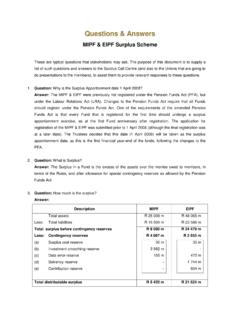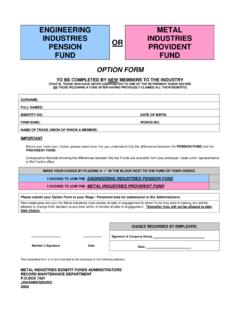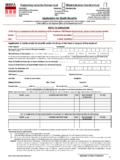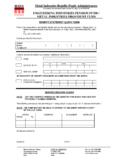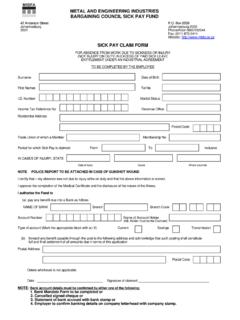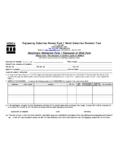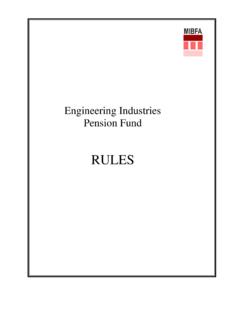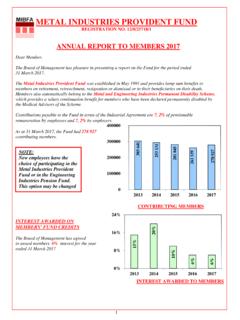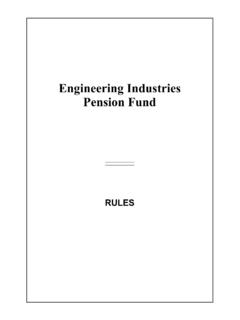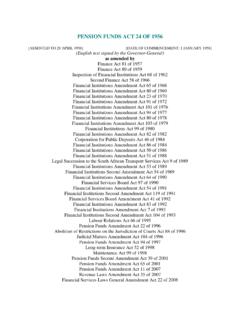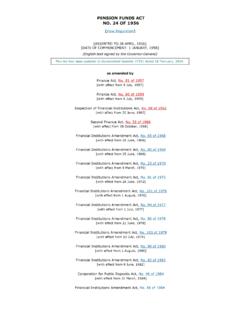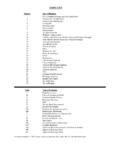Transcription of Surplus Apportionment Information Booklet - MIBFA
1 Page 1 Engineering Industries Pension Fund Surplus Apportionment Information Booklet Page 2 Index 1. Introduction Page 3 2. History of EIPF Page 3 3. Stakeholders Page 4 4. Actions by the Board of Trustees to obtain all the former member data Page 5 5. Financial position of the EIPF prior to the Surplus Apportionment Page 5 6. Surplus deemed improperly utilised by the employer Page 5 7. Contingency reserves Page 5 8. Surplus available for Apportionment Page 6 9. Prescribed minimum benefits : Former members Page 7 10. Prescribed minimum benefits : Pensioners Page 8 11. Remaining Surplus Page 9 12. Summary of the Apportionment as at 1 April 2008 Page 11 13. Statements by the Former Member Representative Page 11 14. Application of Surplus allocation amounts Page 12 15. In summary Page 13 16. Next steps required from Stakeholders Page 13 Annexure 1 Deaths on or after 1 April 2008 Page 14 Page 3 Engineering Industries Pension Fund ( the EIPF ) (12/8/5040) Surplus Apportionment scheme as at 1 April 2008 Report by the Trustees 1.
2 Introduction The Pension Funds Second Amendment Act, 2001 (the Act) requires all pension funds to allocate any Surplus on a basis as set out in the Act. The Surplus Apportionment date for the Engineering Industries Pension Fund (also referred to as the EIPF ) is 1 April 2008. The purpose of this document is to inform all stakeholders on the Surplus Apportionment scheme, as approved by the Trustees. 2. History of the EIPF A fund known as the Metal Industries Group Life and Provident Fund (also referred to as the MIGLPF ) was established effective 29 July 1957. During 1975 the fund converted to a defined benefit structure. On 31 March 1990 the MIGLPF changed its name to the Engineering Industries Pension Fund (EIPF). On 1 May 1991 the Metal Industries Provident Fund (MIPF) was established as a defined contribution provident fund. EIPF members were given the option to transfer to the MIPF during the period 1 October 1993 to 28 February 1994.
3 A large number of the members of the EIPF elected to transfer to the MIPF. A separate fund, known as the Metal Industries Group Pension Fund (also referred to as the MIGPF ) was established effective 7 February 1966. Members of the MIGPF were given the option to transfer to the MIPF with effect from 1 May 1991. A large number of the members of the MIGPF elected to transfer to the MIPF. On 1 January 1995 the remaining members of the MIGPF were transferred into the EIPF and the MIGPF ceased to exist. In terms of the law, former members of the MIGPF who exited before 1 January 1995 (the date when the MIGPF merged into the EIPF) are not regarded as stakeholders in the Surplus Apportionment scheme for the EIPF as they never contributed and belonged to the EIPF. Page 4 3. Stakeholders The following parties are considered as stakeholders in terms of the Act and must be included in the Surplus Apportionment scheme as at 1 April 2008: Former members of the EIPF [a total of 202 810 qualifying former members] These are all members who left the EIPF (previously known as the MIGLPF) over the period 1 January 1980 (the date specified in the Act) until 31 March 2008 and who previously received a benefit from the EIPF, that is, all withdrawals, transfers and retirements during this period.
4 Active members as at 31 March 2008 [a total of 30 536 active members] These are all members who were members of the EIPF as at 31 March 2008. If any of these members withdrew, died or retired on/after 1 April 2008 they are still taken into account as active members. Pensioners as at 31 March 2008 [a total of 41 236 pensioners] These are all persons as at 31 March 2008 who receive a pension income from the EIPF. Paid-up members as at 31 March 2008 [a total of 1 478 474 paid-up members] These are all members who left the EIPF before 31 March 2008 whose benefits have not yet been claimed and/or paid. Some of these members will only become entitled to their accumulated fund benefits at a future date (once they reached retirement age). Others have already become entitled to benefits, but have not claimed the benefits as such. In the actuarial valuations the value of the paid-up members benefits are reserved for as part of the liabilities of the EIPF.
5 The various participating Employers The following parties are legally not regarded as stakeholders of the EIPF and have been excluded from the Surplus Apportionment scheme. All former members who died before or on 31 March 2008. All former members who exited before 1 January 1980 (date specified in the Act) and received their benefits in terms of the Rules of the EIPF. All pensioners who died before or on 31 March 2008. All members who entered the EIPF on or after 1 April 2008. The Trustees have appointed Mr David Levy as Former Member Representative to represent the interests of former members in the discussions regarding the Surplus Apportionment scheme. 4. Actions by the Board of Trustees to obtain all the former member data Page 5 MIBFA , the Administrator of the EIPF, provided the membership data as recorded on their systems. The Trustees also placed advertisements in various newspapers, both on a national and regional level, to invite former members to come forward and register as a stakeholder in the Surplus Apportionment scheme.
6 Similarly, broadcasts were made on several community radio stations to make people aware of the Surplus Apportionment exercise. Posters and pamphlets were distributed to the various participating employers and unions. A special Surplus Call Centre was established to deal with all the Surplus enquiries and registrations. The Unions will be hosting Information sessions to inform member stakeholders of the Surplus Apportionment scheme. Please contact your Union representative to get more detail in this regard. 5. Financial position of the EIPF prior to the Surplus Apportionment An actuarial valuation of the assets and the liabilities of the EIPF was completed as at 1 April 2008. The valuation indicated a total Surplus of R 24 479 million, prior to the investigation of any improper use of Surplus by the employers (refer to Section 6 of this Booklet ) and prior to the establishment of any contingency reserves (refer to Section 7 of this Booklet ).
7 6. Surplus deemed improperly utilised by the employer Section 15B(6) of the Act stipulated four instances of utilisation of Surplus which are deemed as being improperly utilised and requires all pension funds to investigate such usages of Surplus . An investigation into the financial history of the EIPF over the period 1 January 1980 (date specified in the Act) up to the Surplus Apportionment date of 1 April 2008 was done with the aim of determining whether any Surplus was utilized improperly by the employers, as defined in Section 15B(6) of the Act. No cases of improper use of Surplus on the part of the employers could be identified. 7. Contingency reserves The Act allows the establishment of contingency reserves to protect the EIPF against specific contingencies. The Registrar of Pension Funds limited the use of such reserves with the issue of a special Information circular. The contingency reserves are subject to the Registrar s approval.
8 After careful consideration the Board of Trustees, on recommendation of the EIPF s Valuator and taking into account the financial position of the EIPF as at the Surplus Apportionment date, have decided on the following reserves: Surplus Cost Reserve The EIPF conducted a complete budget process in order to determine the expected costs of a full Surplus Apportionment exercise for the EIPF. An amount of R 35 million is reserved for the expected expenditure. This implies an average cost provision of approximately R 20 per member stakeholder. Any savings on the Surplus cost budget will, within practical limits, be added to the Surplus available for Apportionment before the approved scheme is implemented. Page 6 Solvency Reserve The purpose of the solvency reserve is to protect the EIPF against the risk of insolvency as a result of adverse future experience for which no provision was made in the valuation. The value of the Solvency Reserve amounts to R 1 744 million and was calculated on the method as prescribed by the Registrar.
9 Contribution Reserve The levels of member and employer contributions have been negotiated by the employer and trade union parties in terms of a collective agreement through the Metal and Engineering Industries Bargaining Council. These contributions are not sufficient to provide for the defined benefits described in the Rules of the Fund. A Contribution Reserve of R 604 million was set aside to cover the expected shortfall in future contributions for a three year period following the Surplus Apportionment date. Data Error Reserve The purpose of this reserve is to protect the EIPF against the risk that the Surplus is over-estimated because of data errors and omissions in the actuarial valuation and the extensive Surplus Apportionment exercise. An amount of R 472 million (approximately 2% of the liabilities as at 1 April 2008) was therefore allocated to a Data Error Reserve. 8. Surplus available for Apportionment The Surplus available for Apportionment as at 1 April 2008 is as follows.
10 1 April 2008 Value of assets R 48 065 million Value of liabilities R 23 586 million (a) Active members 4 350 million (b) Pensioners 10 435 million (c) Paid-up members 8 801 million Total actuarial Surplus prior to the establishment of contingency reserves [calculated as minus ] R 24 479 million 1 April 2008 Page 7 Contingency reserve accounts R 2 855 million (a) Surplus Cost Reserve 35 million (b) Solvency Reserve 1 744 million (c) Contribution Reserve 604 million (d) Data Error Reserve 472 million Surplus available for Apportionment as at 1 April 2008 [calculated as minus ] R 21 624 million The Act determines that former members and pensioners have first right to the distributable Surplus , but only to the extent that the benefits already paid to them (as determined in terms of the Rules of the EIPF) are lower than the prescribed minimum benefit (as determined by the Act). [Refer to Sections 9 and 10 of this Booklet for more detail on the calculation of the minimum benefits for former members and pensioners.]
